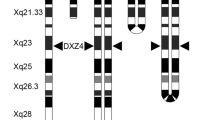Abstract
In cells of fragile X patients, the changed X segment may appear as a poorly staining region or a gap, or as a deletion, involving one or both chromatids. To find out whether the fragile site represents ah incompletely replicated DNA sequence, as has been suggested recently, we analyzed the four chromatids of methotrexate-induced endoreduplicated fragile X chromosomes. Our main observations were: (1) a deleted chromatid was never internal to a poorly staining one; (2) an endoreduplicated X chromosome with a fragile site never included a normal chromatid. These results can be explained by assuming that DNA at the fragile site, when replicated in the presence of methotrexate, may undergo defective replication and give rise to improperly packaged chromatin, appearing as a chromatid with a poorly staining region or a gap in the following metaphase. The same DNA may fail to function as a template in the following S-phase and give rise to a chromatid with a single-stranded segment, appearing as a deleted chromatid in the following metaphase.
Similar content being viewed by others
References
Brookwell R, Turner G (1983) Resolution banding and the locus of Xq fragile site. Hum Genet 63:77
Craig-Holmes AP, Shaw MW (1976) Cell cycle analysis in asynchronous cultures using the BrdU-Hoechst technique. Exp Cell Res 99:79–87
Crossen PE, Morgan WF (1979) Proliferation of PHA-stimulated lymphocytes measured by combined autoradiography and sister chromatid differential staining. Exp Cell Res 118:423–427
Dutrillaux B, Fosse AM, Prieur M, Lejeune J (1974) Analyse des echanges de chromatides dans les cellules somatiques humaines. Chromosoma 48:327–340
Froster-Iskenius U, Felsch G, Schirren C, Schwinger E (1983) Screening for fra(X)(q) in a population of mentally retarded males. Hum Genet 63:153–157
Glover TW, Berger C, Coyle J, Echo B (1984) DNA polymerase alpha inhibition by aphidicolin induces gaps and breaks at common fragile sites in human chromosomes. Hum Genet 67:136–142
Goyanes VJ, Schvartzman JB (1981) Insights on diplochromosome structure and behaviour. Chromosoma 83:93–102
Grzeschik KH, Kim MA, Johannsmann R (1975) Late replicating bands of human chromosomes demonstrated by fluorochrome and Giemsa staining. Humangenetic 29:41–59
Howard-Peebles PN, Pryor JC (1981) Fragile sites in human chromosomes. I. The effect of methionine on the Xq fragile site. Clin Genet 19:228–232
Klinger HP (1972) Rapid processing of primary embryonic tissues for chromosome banding pattern analysis. Cytogenetics 11:424–435
Kondra PM, Ray M (1978) Analysis of DNA replication patterns of human fibroblast chromosomes. The replication map. Hum Genet 43:139–149
Krumdieck CL, Howard-Peebles PN (1983) On the nature of folic acid sensitive sites on human chromosomes. An hypothesis. Am J Med Genet 16:23–28
Latt SA, Willard HF, Gerald PS (1976) BrdU-33258 Hoechst analysis of DNA replication in human lymphocytes with supernumerary or structurally abnormal X chromosomes. Chromosoma 57:135–153
Lau YF (1983) Studies on mammalian chromosome replication. Exp Cell Res 146:445–450
Levan A, Hauschka TS (1953) Endomitotic reduplication mechanisms in active tumor of the mouse. J Natl Cancer Inst 14:1–43
Liskay RM, Prescott DM (1978) Genetic analysis of the G1 period: Isolation of mutants (or variants) with a g1 period from a Chinese hamster cell line lacking G1. Proc Natl Acad Sci USA 75:2873–2877
Lubs HA (1969) A marker X chromosome. Am J Hum Genet 21:231–244
Nussbaum RL, Ledbetter DH (1986) Fragile X syndrome: a unique mutation in man. Annu Rev Genet 20:109–145
Perry P, Wolff S (1974) New Giemsa method for the differential staining of sister chromatids. Nature 251:156–158
Schnedl W (1967) Geregelte Anordnung der chromatiduntereinheiten in den diplochromosomen bei der endoreduplikation. Humangenetik 4:140–152
Sutherland GR (1979a) Heritable fragile sites on chromosomes. I. Factors affecting expression in lymphocyte culture. Am J Hum Genet 31:125–135
Sutherland GR (1979b) Heritable fragile sites on human chromosomes III. Detection of fra(X)(q27) in males with X linked mental retardation and their female relatives. Hum Genet 53:23–27
Sutherland GR (1983) The fragile X chromosome. Int Rev Cytol 81:107–143
Sutherland GR, Baker E (1986) Effects of nucleotides on expression of the folate sensitive fragile sites. Am J Med Genet 23:409–417
Sutherland GR, Baker E, Fratini A (1985) Excess thymidine induces folate sensitive fragile sites. Am J Med Genet 22:433–443
Sutou SH, Arai Y (1975) Possible mechanisms of endoreduplication induction. Exp Cell Res 92:15–22
Taylor WH, Hagerman PJ (1983) Biochemistry of the fragile X syndrome. In: Hagerman RJ, McKenzie P (eds) The fragile X syndrome — Diagnosis biochemistry, intervention. McBogg, Spectra Publishing, pp 115–151
Tice R, Schneider EL, Rary JM (1976) The utilization of bromodeoxyuridine incorporation into DNA for the analysis of cellular kinetics. Exp Cell Res 102:232–236
Wolff S, Perry P (1974) Differential Giemsa staining of sister chromatids and the study of sister chromatid exchanges without auoradiography. Chromosoma 48:341–353
Author information
Authors and Affiliations
Additional information
Dedicated to the memory of Professor Menashe Marcus, teacher, colleague, arid friend
Rights and permissions
About this article
Cite this article
Kerem, B., Goitein, R. & Schaap, T. Cytological evidence of defective template in the fragile X chromosome. Chromosoma 97, 6–10 (1988). https://doi.org/10.1007/BF00331789
Received:
Revised:
Issue Date:
DOI: https://doi.org/10.1007/BF00331789




